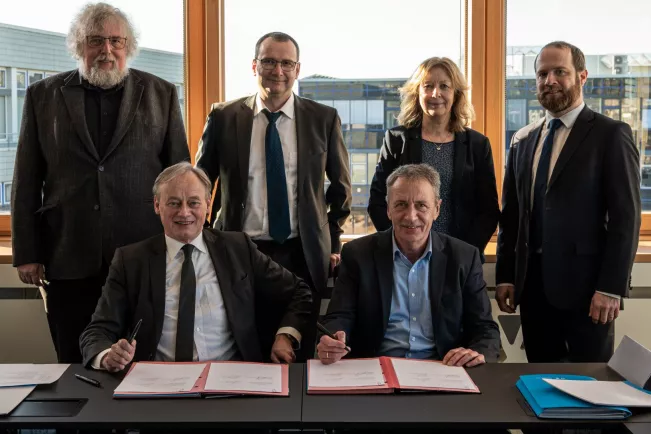Communications and Marketing
University and DLR strengthen cooperation in security research

Ranging from the protection of critical infrastructures such as airports, railway stations or public authorities to the detection of bacteria or viruses in the health sector: "The detection of hazardous substances actually affects all areas of our society," said Professor Peter Kaul, founding director of the Institute for Safety and Security Research (ISF) at the H-BRS and project leader on the part of the university. Four institutions of the project partners are involved in setting up the cluster. In addition to the ISF, the university's Institute for Detection Technologies (IDT) is participating. Furthermore, the DLR institutes for the protection of terrestrial infrastructures and for aerospace medicine are involved.
"With the founding of the Institutes for Security Research and Detection Technologies in 2011, the university took up the issue of security as a central factor for civil, technical, digital and human security and development," emphasised university president Hartmut Ihne at the signing ceremony. The research cluster will further strengthen this focus.
Synergies in addressing pressing issues of hazardous materials detection and critical infrastructure protection
The Institute for the Protection of Terrestrial Infrastructures as a new DLR institute is located in Sankt Augustin in the immediate vicinity of the university, and a new institute building is planned on the Butterberg. This creates short distances also to the newly inaugurated Competence Centre for Aerospace Medicine in Cologne, which is also active in security research. The university institutes IDT and ISF already have an excellent laboratory infrastructure in Rheinbach. "The research cluster for hazardous substance detection offers the best conditions for the expansion of research infrastructure in the region, joint intensive research and scientific qualification in direct exchange," said Klaus Hamacher, Deputy Chairman of the DLR Executive Board.
With the four research institutes involved, the joint cluster, in other words a research network, creates synergies in solving urgent questions on the detection of hazardous substances and the protection of critical infrastructures. "With the merger, we want to advance joint research projects. Our competences complement each other perfectly," said H-BRS professor Peter Kaul.
The main areas of research at H-BRS include, for example, detection methods for chemical hazardous substances or explosives as well as chemical analysis in the trace and ultra-trace range using chromatographic methods. But also the development of training concepts and aids for sniffer dogs, including their performance testing, are part of this. DLR completes the range with expertise in the detection of biological, radiological and nuclear hazardous substances, so that the entire CBRNE spectrum is covered. Furthermore, DLR makes its capacities and expertise in the field of electronics and electrical engineering available to the cluster.
The first steps of the joint research cluster on the detection of hazardous substances will be a regional competence and needs analysis, the expansion of the network with other research institutions and federal authorities, and the coordination of research activities between the partners.
Media contacts:
Prof. Dr Peter Kaul
Hochschule Bonn-Rhein-Sieg
Institute for Safety an Security Research
Phone +49 2241 865 515
Email: peter.kaul@h-brs.de
Michael Langerbeins
Deutsches Zentrum für Luft- und Raumfahrt e. V. (DLR)
Acting Director of the Institute for the Protection of Terrestrial Infrastructures
Phone +49 2241 201 4801
E-Mail: michael.langerbeins@dlr.de
Press photo information:
Contact

Daniela Greulich
Deputy Head of executive department Communications and Marketing/Press and Public Relations, Press Officer
Location
Sankt Augustin
Room
E 237
Address
Grantham-Allee 20
53757, Sankt Augustin
Telephone
+49 2241 865 641